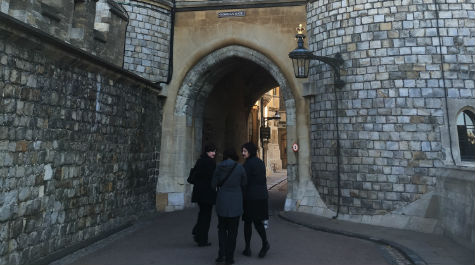Retracing the steps of a 1929 fact-finding mission
Nearly nine decades ago, William & Mary President J.A.C. Chandler arrived in London on a mission to explore the history of the university. Recently a small delegation from W&M Libraries retraced his steps for an investigation of their own.
Their search would take them to several U.K. landmarks including Hampton Court Palace and Windsor Castle to learn more about the university’s namesakes, William III and Mary II.
“The reign of William and Mary is frequently overshadowed by other English dynasties, but as a dual monarchy, it was unique,” said Dean of University Libraries Carrie Cooper. “As we approach the celebration of 100 years of co-education at the College, it’s important to note that our university bears the name of a woman who was not only a queen by marriage but by blood, who led her country equally with her husband.”
For W&M University Archivist Kim Sims, retracing Chandler’s trip offered the chance to discover information about the university that has been hidden from public eyes for centuries.
“As an archivist and history lover, visiting the Royal Archives and Royal Library was a dream come true. The collections are so varied and rich. It was an exciting opportunity,” said Sims.
In April 1929, guided by instructions from university librarian Earl Gregg Swem, Chandler visited London searching for documents relating to the founding of the university. Sims retrieved letters from the university archives, detailing the prep work Swem put into Chandler’s visit.
“We have a few of the letters leading up to Chandler’s visit, in which Swem suggested topics of research and possible locations of relevant documents,” said Sims.
In a letter dated March 26, 1929, Swem advises Chandler to investigate where the original charter was filed in London, as he hoped the discovery would lead to other materials relating to university history. He writes, “Where the charter of the College is filed, do you not think it likely that a good many other documents concerning it would be also, probably the original petition with signatures and date about the colony, etc.”
Swem also advised Chandler to research English architects connected to the university. In a letter to Chandler, dated March 23, 1929, Swem writes, “I believe it is still possible to find out something about Thomas Hadley, who had charge of building the main building here, and possibly in some of the papers of architects of that time there may be some reference to Hadley.”
While Swem certainly invested a lot of time and effort into Chandler’s trip, it doesn’t appear to have paid off. On a postcard Chandler sent to Swem during his trip, Chandler writes, “Great deal of material are here. Hard to get at. Tell you it is in the ‘Library of Congress.’ Wish you could come over and work on some of things over here.”
“Unfortunately, President Chandler had little success finding university-related documents, but this made us more hopeful that we would have the opportunity to view materials that very few researchers had seen before,” said Sims.
During their visit, the library delegation was treated to tours of the Royal Archives and Royal Library by Royal Librarian Oliver Urquhart Irvine. The group saw a number of treasures relating to William and Mary’s reign, including an account book for Mary’s room furnishings; a lock of hair belonging to Mary’s stepmother, Anne; a book listing births, deaths and marriages of Mary and her siblings; a pocket watch bearing William’s cypher; and an account book written by Mary herself when she was Princess of Orange.
"We learned several facts about William and Mary, like that Mary was born at 1 in the morning, but the item that impacted me most was William and Mary’s coronation book, containing their signatures. That was the first time I had seen Mary’s signature. It was an exciting moment,” said Sims.
The library delegation also visited Hampton Court Palace, one of the royal residences of William and Mary. According to Daniel Jackson, curator of historic buildings, Mary was a driving force in the rebuilding of Hampton Court Palace.
“After William and Mary moved into Hampton Court Palace, Mary asked Christopher Wren to redesign the palace. Daniel described a letter written by Christopher Wren’s son in which he wrote that Mary was very involved in the plans for the new palace,” said Cooper.
Jackson provided a behind-the-scenes tour of the palace, pointing out the many William and Mary cyphers that adorn the building and sharing facts about the monarchs. William’s hero, Jackson said, was the demi-god Hercules as evidenced by the many statues and paintings in the palace. Mary collected exotic plants such as orange trees and cacti, varieties of which are still kept on the premises.
“Seeing William and Mary’s home and hearing about their interests and passions made them more fully developed in my mind as real people, not just names of our institution,” said Cooper.
Sims is proud that the library delegation made such progress in their fact-finding mission.
“We learned a great deal of information about our university during our trip,” Sims said. “Most importantly we were able to build important relationships with the librarians and archivists in the Royal Archives. We’ve only scratched the surface of the discoveries that can be made there.”
For more information about Chandler’s 1929 trip to England, visit the exhibit currently on display at the Muscarelle Museum. “Hark Upon a History: The 1929 Journey to England,” curated by Sydney Stewart ’16 and Michaela Wright ’16, marks the first time that materials pertaining to the journey are on view.



















